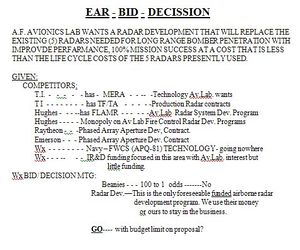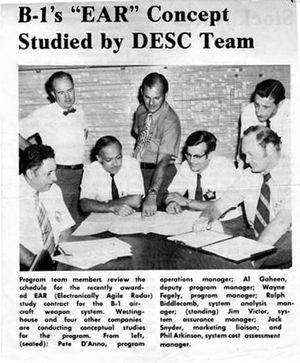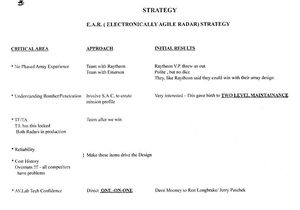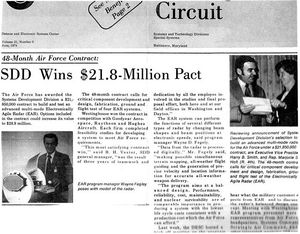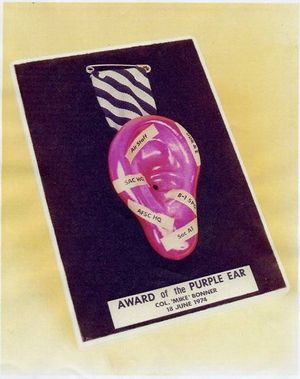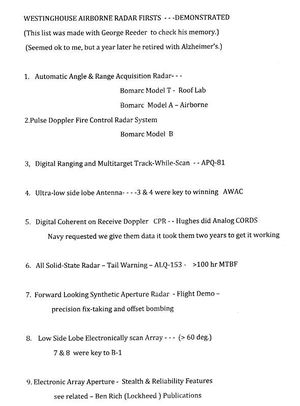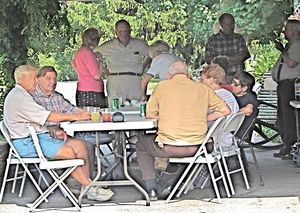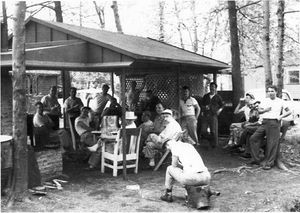Oral-History:Wayne Fegely
About Wayne Fegely
Wayne Fegely was born and raised in Mertztown, Pennsylvania, growing up on a farm in the Pennsylvania Dutch area. When he was young he developed an interest in science, particularly in batteries, and kept his family’s radio operational. Two semesters after entering Lehigh University in electrical engineering, Fegely was drafted into the Navy, where he acquired a strong grounding in electronics. After leaving the Navy, Fegely returned to Lehigh, majoring in power transmission. After graduating, Fegely joined Westinghouse in Pittsburgh, receiving his Masters from the University of Pittsburgh specializing in servomechanisms. In 1950, Fegely transferred to Baltimore and over his forty-two year career at Westinghouse served in many departments – such as Air Arm Division, Radar Development Section, and Advanced Development Engineering – and many projects – like radar, stealth and EAR.
In this interview, Fegely discusses the many projects he was a part of, highlighting those of particular importance such as EAR and stealth. Fegely also discusses some of his colleagues at the Westinghouse Electronic Systems Division like Harry Smith, Paul Pan and Bill Skillman. He also talks about being part of management at Westinghouse and how the business itself worked, as well as his role of trying to search for new technologies to expand Westinghouse's activities. He also talks about the race for contracts that pitted Westinghouse against other companies like Raytheon and Hughes, and the working environment in Baltimore.
Note: Additions to the oral history made in later edits by Wayne Fegely are marked with [..]. Fegely also added documents and pictures as addendums -some are reference footnotes, while others are embedded within the text.
About the Interview
WAYNE FEGELY: An Interview Conducted by Sheldon Hochheiser, IEEE History Center, 12 July 2009
Interview #511 for the National Electronics Museum and IEEE History Center, The Institute of Electrical and Electronics Engineers Inc.
Copyright Statement
This manuscript is being made available for research purposes only. All literary rights in the manuscript, including the right to publish, are reserved to the National Electronics Museum and to the IEEE History Center. No part of the manuscript may be quoted for publication without the written permission of the National Electronics Museum and the Director of IEEE History Center.
Request for permission to quote for publication should be addressed to The National Electronics Museum, P.O. Box 1693, MS 4015, Baltimore, MD 21203 and to the IEEE History Center Oral History Program, IEEE History Center, 445 Hoes Lane, Piscataway, NJ 08854 USA or ieee-history@ieee.org. It should include identification of the specific passages to be quoted, anticipated use of the passages, and identification of the user.
It is recommended that this oral history be cited as follows:
Wayne Fegely, an oral history conducted in 2009 by Sheldon Hochheiser, IEEE History Center, Piscataway, NJ, USA at the National Electronics Museum, Linthicum, MD, USA
Interview
Interview: Wayne Fegely
Interviewer: Sheldon Hochheiser
Date: 21 July 2009
Location: National Electronics Museum, Baltimore MD
Background and Education
Hochheiser:
Today’s July 21st, 2009. This is Sheldon Hochheiser of the IEEE History Center. I’m here at the National Electronics Museum in Maryland with Wayne Fegely. Did I pronounce your name correctly?
Fegely:
Yes, you did.
Hochheiser:
Good. Wayne’s going to talk to us about his life and his career at Westinghouse in Baltimore. Good afternoon.
Fegely:
And how are you?
I was born in Mertztown, Pennsylvania in the Pennsylvania Dutch area, Longsdale was our valley. The family has lived here since arriving at Philadelphia in 1733.
Hochheiser:
What did your parents do?
Fegely:
Dad grew up on a farm, during the Depression he worked at a bakery. After that he worked as a machinist at Mack Truck during the war. A tank casting fell and crushed his hand, but he kept working at Mack. They kept a job for him till he retired. My mother was a teacher; she graduated from Kutztown State Teachers College. She substituted at several local one-room schools and would take me along on “good days.” I could ring the bell at recess and keep the fire going.
Hochheiser:
Were you interested in technology and science as a youth?
Fegely:
[Interposing] No. Not really. I grew up on a one-horse farm. We borrowed the neighbor’s horse to do the plowing.
Hochheiser:
[Laughter]
Fegely:
Oh yes, I was interested in science. In fact, I thought I’d make my career in batteries. Six-volt batteries, kerosene lights and wood stoves were our household energy source. The REA hadn’t reached us yet. A six-volt dry cell battery for a discarded non-superhet radio was our contact with the world outside of Longsdale. I was in charge of keeping the radio running so we (my sister and three brothers) could listen to The Lone Ranger and Mom could listen to the news. A cat whisker set I made didn’t hack it. I was very fortunate to have several people help me learn things and get me to college.
Four were very important to me, they were: First: Ralph Merkle, my math /science teacher at Longswamp Township High school, a four room 11 grade school. Plus another small room for math and science for grades 9 to 11 where Mr. Merkle ruled. He said we could go to college after he was finished with us, if we passed. He was right but most colleges required 4 years of English and we only had 3 and spoke mostly Pa Dutch. Second: Rev. Luther Schlenker, my pastor, who took me to Muhlenberg for a scholarship test. Got one, but wasn’t keen on becoming a minister. Third: Oscar Stein, my history teacher at Kutztown High School. I had known Mr. Stein through the Boy Scout Eagle Program. He took me to Lehigh and enabled me to get a $150 scholarship. Fourth and foremost: Marie Fegely, my mother, who guided me well and sold all the chickens to raise the extra $150 needed for the first semester. [Laughter]
Hochheiser:
And did you have a particular program of study in mind when you went to Lehigh?
Fegely:
Yes. I was interested in batteries, so it was electrical engineering. I started immediately, that summer. Lehigh was on a three semester year, classes were pretty small. I made the varsity wrestling team that year.
Hochheiser:
Right.
Fegely:
But I got drafted after two semesters. That was fortunate, because I was out of Longsdale to see the rest of the world. It was quite different. In fact, during my interview with the Bursar at Lehigh he said I would never be able to graduate until I learned to speak English.
Hochheiser:
[Laughter]
Fegely:
And I now know what he meant. Passing the Eddy Test got me into the Navy ETM (Electronics Technician’s Mate) schools. Great Lakes, Hugh Manley, Gulfport, Navy Pier Chicago. Didn’t volunteer for the Bikini Tests and stayed to help dismantle Navy Pier. The Navy gave me my electronics base, like so many others at Westinghouse Air Arm.
Hochheiser:
Sure.
Fegely:
After the Navy I came back to Lehigh to finish my BSEE majoring in power transmission. Joining the local power company, PPL (Pennsylvania Power and Light) was my intention, but I chose Westinghouse where I could learn how the equipment was designed and built, and be better able to use it.
Joining Westinghouse
Hochheiser:
So you joined Westinghouse upon completing your bachelor’s degree?
Fegely:
Yes, I started on the Westinghouse Graduate Student Program, working for 5 to 6 weeks at five different plants in different departments. Dr. Sy Herwald, Special Products Division Mgr., convinced me to join one of their many development projects. I could join the transmission tie-line regulator project.
Hochheiser:
Where was the Special Products Division?
Fegely:
Special Products was in Pittsburgh on Ardmore Blvd. down from the Research Labs and the new field of servomechanisms intrigued me. Got my MSEE from the University of Pittsburgh in servomechanisms. My first job was to assist the Research Labs under Dr. John Coltman to devise components for a CW Doppler radar.
Hochheiser:
So this is still in Pittsburgh.
Fegely:
Yes, I still remember my job was to keep an antennae aimed at a plane flying overhead so they could measure the transmit power and return Doppler signal. The next task was to design the antenna servo amplifier for the Bomarc Model T Missile.
Hochheiser:
Okay. And is that still in Pittsburgh?
Fegely:
Yes. With guidance from Dr. Frank Malich, I chose Mag Amps as the final drive. Used that work for my Masters Thesis, slight problem with security clearance.
Hochheiser:
Right.
Fegely:
Searching and locking on to a target due to the large inertia of the mechanical scan antenna was finally accomplished by stopping the antennae, and backing up as a function of antennae scan velocity. Computations were done via analog mechanical servos.
Air Arm Division
After getting the prototype working, I was the first engineer to transfer to the new Air Arm Division at the Baltimore airport.
Hochheiser:
When was this?
Fegely:
That would be in fall of ’50.
Hochheiser:
You were actually working out of rented space at the airport at the time?
Fegely:
Yes. All of Pier B was rented and the radar group was in the baggage handling area. The steps to the lower level were used for the library and parts purchasing.
Hochheiser:
[Laughter] But you were a very small group at this time.
Fegely:
Yes. There was John Adkins, radar group leader, Jack Darr, myself, a couple technicians and several microwave engineers who were still at the Wilkins Ave Plant. Shortly, Adam Kegel, servomechanisms group leader, came down from Special Products. George Axelby with MIT servo background was the first outside hire.
Hochheiser:
How long were you at Pier B before you moved on to—
Fegely:
[Interposing] It was at least a year.
Hochheiser:
Yes.
Fegely:
We did lots of experiments in that baggage laboratory.
Hochheiser:
[Laughter]
Fegely:
Including using hydraulics for the bomber tail turret radar. I believe it was Ernie Coulter who blew a hydraulic line and doused everybody with hydraulic oil.
Hochheiser:
[Laughter]
Fegely:
But those were fun days.
Hochheiser:
Yes, so after about a year the plant building was finished, and you moved off the airport property.
Fegely:
We moved when the engineering lab, model shop and engineering office were completed. As I remember, computer and purchasing located behind ticketing counter moved several months later. Other offices and manufacturing were still being built. (west end).
Hochheiser:
Right.
Fegely:
The development Model T radar was shipped to Boeing and the project was transferred to the Design Engineering Dept. for the production of the Model A radars. Production was only a few hundred because of the down look clutter problem associated with low flying targets.
Hochheiser:
Right
Radar Development Section
Fegely:
We knew the Air Force had started a development program with Raytheon for a Doppler radar to solve this problem. Our task now was to come up with a better radar system before Raytheon and do it without government funding.
Hochheiser:
So how were those problems solved?
Fegely:
We established a Radar Dev. Section with Harry Smith as manager and went full bore with IR&D funds, working around the clock with a dedicated group of engineers. Eg: Transmitter- Bill Dempsey and Lou Heyser, STALO – Herb Grauling, PRF/ranging – Walt Ewanus, System –Dave Mooney, with Harry coming in each morning with a new idea to solve yesterday’s problem. The Model A antenna was adequate and I only needed to keep it working. Not much to do till there was hardware to test. This work produced the first pulse doppler production radar (DPN 53) for the Bomarc B missile providing a look-down shoot-down capability. How the problems were solved in each of these areas is explained in “ The Story Of Westinghouse Electronics Systems Airborne Radar” by Gene Strull.
Hochheiser:
Right.
Fegely:
It’s about 1955 now and I became a Supervisor.
Knowing that the inertia of mechanical scan antennae would limit future airborne applications, I started searching for technologies to provide multiple target tracking on the fly. Components for airborne phased arrays, transmit/receive elements and signal processing awaited future development. Working with the Research Labs, our Advanced Technology Lab and with outside component manufacturers seeding them with some of our IR&D funds, we finally got there 10 years later. Ala APQ 81 & EAR.
Government Contracts and NRL
I would like to comment on the relationship between Government technical contract monitors and Westinghouse. It was quite different back then. Although they held the hammer, they respected our technical ability and together we tried to get the best design for the money available. For example: When Joe Legin was having a show and tell review of his computer system with NRL, we blew smoke via a spaghetti tube from the next lab. NRL remembered and later returned the favor. For almost a year I commuted daily to NRL going over the APQ 50 antennae servo design with George White in Pete Waterman’s department. He insisted on using a mechanical calculator going out to the 11th decimal place because of multiple inner loop interaction. I used my K&E Log Log Duplex Trig slide rule, which proved accurate enough. When the time came to test the antenna system under vibration, Pete decide to load the antenna with hidden loose nuts and bolts and invited Dr. Sy Herwald, Air Arm Division Mgr., to witness the test. He swore me to secrecy. I wasn’t worried because Sy was the center fielder for our Dev. Engr. fast pitch softball team. However, Hank Lawton, Design Engineering manager didn’t seem too happy. It was Pete’s way of keeping us on our toes.
Hochheiser:
NRL was the Naval Research Lab?
Fegely:
Yes. Demonstrating new technology has tertiary problems not directly associated with what you’re trying to accomplish. Such as; Radiation: Health did not concern us. We knew if we walked in front of the antenna our eyes would feel warm. None of us that I knew of had any side effects. However, Lilleton Ballard, our klystron man, put a dental x-ray negative with a penny on it in the klystron bay and got an excellent image of Lincoln. He immediately retired. I couldn’t convince him to stay. He was through with defense work. I was more concerned about the high power ground base radar from our neighboring Electronics Div. that scanned over our radar ever 10 seconds. It produced a 2 volt bias on the 2” copper ground strap and caused lots of circuit interference. The covers were off while we were debugging. Needless to say we got it turned off while scanning over us.
Hochheiser:
Yes.
Developing New Radar Techniques
Fegely:
It’s 1955 by now and I became supervisor in the radar section.
Hochheiser:
So by this time had you solved the—?
Fegely:
Antenna problems? Ok for today’s systems but not for the future.
Hochheiser:
Okay. So now we’re off from BOMARC onto - - .
Fegely:
Developing techniques that will be needed for the next generation Navy, Air Force or Army radar.
Hochheiser:
Ah.
Fegely:
You’re doing good if one out of five ideas will be key to winning the next radar.
Hochheiser:
[Interposing] So it’s not that closely tied to any current product?
Fegely:
No. We did assist solving some production problems. But our task was to bring in the next one. Design Engineering Dept. handled production problems.
Hochheiser:
Okay. And about when is this?
Fegely:
It took about two years to convince the Navy we were the ones to develop their long range track-while-scan C-band pulse Doppler radar, the APQ-81 which started in 1961.
Hochheiser:
Okay.
Fegely:
The key techniques for multiple target track-while-scan were changing the prf several times during the antennae beam dwell time, a very low side lobe antenna, digital processing to establish track files, and multiple range gated channels to reduce clutter. [Data from Pete D'Anna: After having been used for the BOMARC seekers, the Pulse Doppler technology in] theAPQ-81’s [pioneering pulse doppler, multiple target, track while scan system] was the [principal] base[line] for our future fire control systems and the driver for the AWACS radar. [The APQ-81was originally used as the radar fire control system for the Bendix long range air to air Eagle Missile System. Through all of these early programs it was] Johnnie Pearson’s persistence [that] got the hardware and test done on time [as was his later skillful management of the AWACS fly-off at Boeing which won this key major program for Westinghouse. Initially a young engineer by the name of Bill Jones explored the application of the AN/APQ-81’s technology to resolving the basic AWACS detection and tracking problem. When] Bill Skillman [became available to the program, his diligent pursuit of the many ramifications for fully developing the full potential of Pulse Doppler techniques earned him the well deserved title as the “Architect” of the AWACS radar system. In his following work on the AWACS program, he was the] technical Guru [assigned to] “Keep AWACS Sold” to the Washington crowd. [It t]ook years to get him back on new programs. Can’t forget Charlie Calhoun’s Chinese Remainder Theorem or Gwen Hays' tenacity to get it done. On the management side, Pete Waterman (NRL) wanted Westinghouse to use a new (to Westinghouse) Program Manager Concept. After a bit of in-house deliberation knowing Pete would not give up,Wx agreed and I became the first Wx Program Manager. I obviously got my guidance from Pete. We did get a follow on program from the Navy–FWCS (Future Weapons Control System). It was flight tested in an A3D.
Moving to Paul Pan’s Programs
By 1963 we finished the program, John Stuntz had taken over radar div. and I was searching for my next opportunity. I guess Harry thought my program manager experience would help get Dr Pan’s programs under control so I transferred. Dr. Paul Pan controlled all IR&D funding, ATL and Electro Optical, which became my responsibility. I found Paul’s rigid Chinese management style somewhat restrictive and ended up in Nick Petrou’s office several times. We never disagreed technically only on who and how we pay for it.
Hocheiser:
When was this?
Fegely:
About 64/65. I now got a quick indoctrination in video cameras, infrared and lasers for both ground, air and space applications. We developed the Apollo TV cameras. Our base technologies were at the Research Labs, Dr. Garbuny’s thermicon and Videocon, at ATL chip and molecular circuitry, and our system design capability. We competed well on tech demo programs, but couldn’t get by Hughes or TI for follow-ons; except for Apollo and Pave Spike. Sensitivity and uniformity of the thermicon and Videocon target retinas were never good enough. BAMBI, a 360 deg bomber defense system, was our biggest try; but that program was cancelled. Too ambitious. Periodically we were asked to solve special problems; One interesting one was a request by Col …, forgot his name, but not his ability to fly a helicopter. Twice a sniper who came out of his mountain top cave had shot him down. We built an acoustic gunfire locater system and tested it at Aberdeen Proving Grounds. I’ll never forget the test. The Col. had stationed his buddies along the flight path to fire just behind the copter. It was my system so I was to fly with him. He flew sometimes almost upside down at tree level. I made it half way and got off. We built 6 systems, but Vietnam ended before he was to take them back.
Returning to Radar Development and CPR
After 1966, I came back to manage Radar Dev. John had moved up to engineering mgr.
During this time, we had a broad range of IR&D efforts such as: high power transmitters using cross field amplifiers, serial synthetic spectrum signal processing, and a digital signal processor; but I would like to concentrate on a very key in-house program we called CPR (Coherent Pulse Radar). CPR might also have been appropriate for resuscitating our radar business, but I’m not sure the term was used at that time.
[It was during this time that we developed and produced the AWG-10 fire control radar system for the US Navy’s new F4H-1 Phantom II carrier based fighter. (Later redesignated the F4B). This was the first PD radar installed in a full production Navy carrier fighter.]
Up to now we had concentrated on air-to-air modes. Hughes via an Air Force dev. program called CORDS (Coherent on Receive Doppler System) was getting close to demonstrating coherent low prf air to ground capability. A radar having both air-to-air and air-to-ground capability would certainly be a winner. Our task was to demonstrate that capability before Hughes. Gathering the resources, key personnel, a prototype APQ 120, an F4D to flight test and George Reeder to lead the charge we went to Harry for approval because we needed most of the IR&D funding. At a meeting with all the Dept heads I outlined the program. The objections were: too expensive, too risky, we’re not in the air-to-ground business, and who is George Reeder? We never heard of him. In Harry’s inimitable way he went around the room asking each to vote. All no’s except for a qualified yes by Joe Dickey who provided the APQ120 and F4D which were absolutely necessary. He then asked Dave Mooney, Advisory Engineer for Radar Dev. “Do we need to do this?” I’ll never forget his blunt answer “ Only if we want to be in the radar business.” Harry said the vote was a tie and he would decide. Everyone cooperated and with George in the back seat flying almost twice a day to verify changes, we were making good progress. Once a month I would take Dave to Dayton for a meeting with Ron Longbrake and Jerry Paschek to tell them how we were coming along and ask how Hughes was doing. Dave repeatedly asked why he had to come and what he should say; “What ever they want to know.” I would be there for about 15 minutes and leave for the rest of the morning. I never asked what they discussed, but they never questioned our technical ability after that. We demonstrated before Hughes did and now the AF door was open. Having an all solid-state receiver for low-prf modes. The AF asked to make the design available to Hughes. I didn’t think it was too bad to have our receiver in a Hughes radar if Ron Longbrake knew it. Later, during the F15 bid Ron told me we knew how to do the low prf modes but management only paid lip service to it. We were a high prf radar house. [This was also a problem with our early development work for the AWACS radar where we had chosen a high prf approach against the medium prf that Hughes was proposing. Our winning system for AWACS was at medium prf.]
Advanced Development Engineering
Hochheiser:
Where are we now?
Fegely:
It is now about 1969.The operation had grown and I was now Manager of Advanced Development Engineering to develop new business for the Defense Group. To climb back from the loss of the F15, Harry wisely chose to develop a company funded low cost radar with a target production price of $200K . It was known as Harry’s WX-200. As Division Mgr, he galvanized the troops and daily, as he did in the development of pulse doppler for Bomarc B, each morning he would have an idea to solve last night’s problem. [This major company effort resulted in the highly successful F16’s APG-66 radar that really saved our bacon in the fighter radar business. Thousands have been produced including later versions which are still in production today.] My role was minimal, manufacturing as cost was the driver.
Hochheiser:
Right.
Fegely:
For the next few years we worked on key technology programs such as: MAIR- Molecular Airborne Integrated Radar- Navy-$ 250K - Dick Bauer program mgr. was the first to demonstrate a configurable array for beam scanning on a 24/32 array. URR – Ultra-Reliable Radar – AF (associate contracts) Wx radar system with TI solid state phased array. [AWACS Critical Technology Development - During the highly competitive conceptual phase there were a number of critical items that had to be proven for the program to proceed. These included a very low side lobe antenna, a very high power airborne Klystron transmitter tube, an extremely stable STALO and a new digital technology data processor. My technology people worked on all of these pioneering developments. The newly developed precision slotted array antenna work was done by a team of Phil Hacker, Al Mace and John Staelin. Jerry Klein was in charge of the development of the new S Band vertically scanning antenna phase shifters and the team of Lou Heyser and Art Quesinberry worked with General Electric to develop the Klystron Power Amplifier. These foundation developments kept us competitive in most of our later programs.] APQ120 - coherent look-down for F4E UPD5- optical correlator for synthetic array radar DIGISAR- Digital Synthetic Array Radar T/R module Development – DARPA $100K- seed money to develop a transmit/receive module using ferrite phase shifters light enough and cost low enough so that about 1800 of them could be used for an airborne antenna. Dave McCann had DARPA responsibility. TI also had a development program from DARPA. They were going to cancel ours. They said we’re too high risk, you’ll never make it. TI wasn’t getting even close either. After weeks of familiarizing Dave with our progress, resources and capabilities we had a meeting with Dr.George Heilmeyer, Director of Development Programs (DDRE) who provided the funds. Referencing the Raytheon module he was convinced that a realistic objective was $2000. Our target was $200 for an airborne antenna. Dr. McCann convinced him to take a chance on us. We did get close enough $250, but that put a production antenna at half a million. Would anyone afford that? Not when we’re selling radars for $200K .Shortly after we completed the program Dr. Heilmeyer showed up as Dir. of Research for TI.
Achieving the $250 cost was due to the miracles performed by Bert Sichelstihl who we convinced to join us and lead the effort. He was working for MAG on a similar program for the Navy. ALQ-163 Tail Warning Radar - The first all solid state radar with > 100 hr mtbf .
EAR Program
I would now like to spend some time on what to me was the most important program for the future of Westinghouse airborne radar.
Hochheiser:
And that was?
Fegely:
EAR
Around 1970 there were no new radar development programs on the horizon and the AF was about to give Hughes a sole source follow-on to FLAMR (Forward Looking Advanced Multimode Radar), which used a Raytheon phased array antenna. Enough complaints were filed and in 1972 Westinghouse, Hughes, Raytheon and Goodyear, each received $400K to define EAR (Electronically Agile Radar). The program emphasis was on “Balanced Design with Life Cycle Cost as the Yard Stick.” After several reorientations, no one could get the balancing they wanted. We turned in the best proposal and on May 14, 1974 were awarded a sole source contract. The included charts and pictures show the key people involved and how we did it. [1]
After 15yrs I could finally see a clear path to a production non-mechanical scan radar and an AF contract at that. This radar was to go on the B1 Bomber.
Hochheiser:
Right.
Fegely:
EAR was to provide all of the forward looking functions necessary for low level bomber penetration under dense radar ground coverage, provide greater range for more effective weapon delivery, better electronic counter-counter measures, better hardening and better survivability.
The five radars it replaced were: 1- Ground Mapping- Find checkpoints, aim points and targets. 2– Air-Air- Defense 3– Automatic Terrain Follow- Fly 100’ over mountaintops. Did that in the BAC 1-11 over the Alleghenies, a bit gut wrenching before the plane pulls up, 4– Terrain Avoidance - Manually 5- Weather Mapping - Avoid dense rain cells Also- velocity measurement, position fix taking, and beacon for tanker rendezvous.
Using most of the APQ-81 team and adding Naomi MacAfee and Warren O’Reilley for reliability /maintenance and life-cycle cost, Jerry Dinkle , marketing, Aris Melissaratos, manufacturing, and pulled in Bill Jones as program manger. The program moved into its own building behind Flight test. Bill did a remarkable thing. He found enough resources and convinced management it was in our best interest in the long run to buy our own test aircraft. A BAC1-11. It was a “God Send” for engineering. Now we wouldn’t be at some remote airbase away from our families to debug the system. The APQ-164 Offensive Radar System for the B-1B bomber was ours if we could keep the costs under control, make the system work as scheduled and the B-I remained viable.
Hochheiser:
So the effort was successful in landing a production contract.
Fegely:
Yes.
Systems Development Division
In 1977 I became Engr. Mgr. of the Systems Development Division responsible for advanced technologies, system applications and obtaining customer contracts. These included Radar, Electro-Optical, Computer and Signal Processors, Electronic Warfare and overall System Engineering functions. It was my task to be the technology and advanced concept developer for all divisions in the Defense Group.
D. Hahn from the Research Labs and I reviewed each division’s IR&D programs suggesting technologies to be investigated for their business. New to me were: Underseas Div - sonar and submarine electronics, Marine Div – ship propulsion and underwater missile launch, Nuclear Bettis/ Monroeville – nuclear power generation and control systems.
Having completed the fail-safe design on the B-1 terrain follow modes, I was asked to participate in the safety review of the Three Mile Island incident. I was surprised that they were still using electro-mechanical latch and hold relays with humans serially in the loop. Admiral Rickover ran a tight ship and change I was told was something he didn’t want to hear, we do it right the first time. The B-1 had duplicate solid-state sensors in multiple closed loops with software designed to immediately cause the B-1 to rise up. Another interesting assignment was participating in the USAF Scientific Advisory Board Summer Study On Long Range Combat Aircraft. Our task was to review and assess the aeronautical technology demands of a long range combat aircraft and the adequacy of the technology base supporting those needs. Participants were, military, gov. civil agencies, academia, retirees (had quite a few conversations with Gen. Doolittle- No wonder he could make those long trips over China, he was quite small - his feet didn’t reach the floor from our conference room chairs). Also contractors. Paul Kinard my counterpart at Hughes was also on the Penetration and Survival Panel.
Presentations of capabilities and studies were made each morning and discussions in the afternoon. I had Demetrius Tsipouras present ECM and Bill Jones the B-1 Radar. Reducing radar cross section was our recommendation but Dr. Teller disagreed and made a presentation to the whole conference as to why that would not work. Basically he believed there would be enough microwave radiation that any object would be able to be tracked passively. I wonder if someone has now tried to array all those sensitive receivers and process the information to determine a true threat. Or better still have a flexible conformal array for airborne platforms. It would change our Stealth approach. However, for that day, radar cross section was it and that became my next mission.
By the way I liked and trusted Paul. We competed, had amiable relations when the Navy asked us to design a radar together because they could only give one contract and wanted both of us to stay in business, and I missed him a few years later when he and many in his group retired when GM bought Hughes. I guess they wanted their IR deer avoidance system more than the radar business. Hughes Airborne never recovered, and our job just became easier.
Development and Engineering Division and Management
Hochheiser:
Where are we now?
Fegely:
From my notes it’s 1982 and I’m now General Manager of the Development and Engineering Division responsible for such new business programs as ATA, ATF, LHX, SHIP and Ground Based Radars, FLIR and EO business.
You probably already know what I’ll be concentrating on now - stealth for aircraft and ships. Didn’t know how that could apply to submarines and I tackled space later.
Before we go on, if you think it’s appropriate, I’d like to mention two management mistakes I made that have bothered me to this day.
Hochheiser:
Please.
Fegely:
After completing the very successful EAR program I wanted to give some type of memento to the Avionics Lab in Dayton. After much soul searching with Tec. Pubs. we ended up with a “purple ear.” Apparently the purple heart connection was not appreciated. It certainly was dumb. The other occurred during my early supervisory days. The antenna servo electronics was packaged in 2x3x1/2 inch potted modules including subminiature tubes. The lab technician Andy and I had a hard time soldering these small wires. His hands were larger than mine. I suggested we get the women in the shop to do it. I’ll never forget the hurt in his eyes. It was his job. We had been working together for the past year and he thought he wouldn’t have a job. I’ve learned to make sure I carefully understand the viewpoint of the person before discussing any item related to their job. I’d also like to mention two other items that effected the survival of the Defense Center Business.
During a meeting at ATL after reviewing our IR&D programs for Doug Danforth, he and John Stuntz got into a somewhat heated discussion of breaking business units into 500 people segments. Danforth made his mark by doing this to avoid union problems. John vigorously in his professorial way showed why that would not be good for the Defense Center. John saved the Defense Center but unfortunately in this case they shot the messenger. Another item relates to Don Povejsil, who headed up the Analysis /Computer Group before going to Headquarters and invented “VABASTRAM,” a value based tool to evaluate Division performance. It was used extensively to evaluate acquisitions and eliminate nonperforming units. Profit was the main driver. In discussing this with Don, I reminded him that our Dev Division should never be asked to make a profit. He agreed and not to worry Harry would take care it. That was solved by the infamous ‘Stuntz Tax.’ Not sure how that affected other business units but my later attempt for space business under different management did not fare well. I’ll mention more on this when we get to my last 6 months, 1991.
Stealth
Hocheiser:
And now you’re into stealth.
Fegely:
The first task was to obtain the proper clearance and need-to-know. The Avionics Lab provided a small interface contract with the aircraft primes to provide an antenna design for each. Lockheed (Skunk Works), Northrop, Boeing and General Dynamics. I really enjoyed those initial conceptual design meetings. Particularly the Skunk Works and Northrop, they allowed far more creativity in aircraft vs. antenna trade-offs. All prototype testing was done at a special air force site. We would receive the test data via each prime, make changes and retest. I suspected Hughes was privy to our data. Hughes personnel worked on the base. We needed to do our own testing, but no such facility existed. We then designed and built the largest and best anti-echoic screen-room. Stealth programs allow lots of in-house management freedom. We didn’t have any trouble with the Beenies this time, the odds were not 100 to 1 against. They were 1 to 2 for the next generation radar: Wx and Hughes. We put the building (Harry B. Smith Laboratories) into the ground bank behind our buildings so as not to attract attention. The Air Force was concerned about keeping the data secure, [which] kinda hid Harry’s building though.
I felt real bullish on this one. We had the best antenna element, the best engineers (Ed Mittelmans -Antenna Dev.Section) and the best test facility. Having the test facility was the best way to prove management interest to the AF. If we beat or equaled Hughes in the tests it would come down to which aircraft and cost. That’s years in the future and not under my watch.
Making a stealth ship also was very interesting and enlightening. In pursuing this business, Nav. Air introduced me to Nicholas Tusch, an Austrian physicist living in England who had developed a paintable radar absorbing material that was being manufactured by Daetwyler in Switzerland. Via the Royal Navy Research Dept. we worked out an agreement; Nicholas would supply the material and we would paint our Navy ships. How do you paint a ship and keep it secret? You find a remote navy yard and put a tent over it and send it to sea at night. Our understanding was Westinghouse would not try to duplicate the material. After a couple ships, management under the pretense of improving the material had our Research Labs analyze the material and try to duplicate it. They never did, but it destroyed our relationship. Nicholas would no longer talk to me. Integrity was what we had, but Westinghouse no longer had it.
Hochheiser:
Right.
Westinghouse Branching Out
Fegely:
It’s now 1989 and I’m getting close to mandatory retirement. As Executive Director, Systems Development and Deputy to the General Manager, Development and Operations Divisions I was like a fish out of water. No line responsibility, no IR&D, no people to lead. By this time I believed our Government Defense business had peaked and we needed to branch out. Commercial was not in our so-called business charter, but I was sure, with the best technical engineering development capability in the world, and Westinghouse’s diverse businesses, I could tackle any emerging field. Having competed with and worked cooperatively with many foreign and U.S. companies, plus having more than 1000 engineers, where at least 50 had doctorates, I felt confident in making that call. Besides our track record was pretty good. When George Reeder was starting to lose his memory I sat down with him and reviewed Wx Radar Dev. work, listing items that Wx had demonstrated first. His memory seemed better than mine, but two years later he retired with Alzheimer’s.
Hochheiser:
Ok.
Fegely:
I was searching for which field to pursue and found it after meeting with our Russian counterparts.
After the demise of the Soviet Union, a meeting was held to explore possible joint ventures. They were desperately looking for ways to stay in business. Some of the technology they offered surprised me. Particularly those related to espionage. What I did learn was they had a low orbit multiple satellite communication system operating for the past year. We could build on that, but should we do work with these people? Besides, Motorola was developing such a system-IRRIDIUM. I thought such a system was too complex and a geosynchronous satellite would better fit our antenna, receiver and integrated circuit capabilities. I was wrong on this one. GPS is big business.
Hochheiser:
Right.
Fegely:
What we do well is track targets. Here we can do it cooperatively. Put a miniature beacon on vehicles and track them anywhere in North America, real time, with one geosynchronous satellite.
I needed someone with experience in this field and low and behold in Ed Mittelmans’ receiver group was Bill McGann, recently hired from Hughes Satellite Division. He had the right background, knowledge, and foresight to develop our plan. Working again with DARPA, a demonstration program evolved that grew faster and bigger than we could keep up with. We put together a proposal team, much of it from Westinghouse divisions: Connecticut TV- programming and up-link (ala Sesame Street), ATL- chip dev., Transportation- vehicle data processing, ITT-satellite positioning and aiming, QUALCOMM-receiver and beacon, DEV, Div program management. It ended up as a joint program with Canada putting up half the funds. We won the contract $ 230K with extensions to $500K. To my dismay the program was immediately transferred to the Communication Division where profit was the priority. Unfortunately this was treated as a drain on Defense Group resources and I was not able to garner enough corporate interest to pull together the various Divisions to develop this business. I only have six months to retire.
That covers the highlights of my 42 years with Westinghouse. Does that cover what you wanted?
Baltimore Working Environment
Hochheiser:
I was going to ask you more broadly about Baltimore, about the Defense Electronics Division as a place to work, in terms of colleagues, camaraderie, social life - the general environment.
Fegely:
Hmm, I was in Pittsburgh for two years.
Hochheiser:
Right. So you have something to compare it with.
Fegely:
Living in a big city, alone, no family, no car, took some getting used to, however two years in the Navy helped make the transition. Work and night courses at University of Pittsburgh took care of the weekdays. What I had difficulty with was finding dates for all the social functions, which were somewhat mandatory. I had joined a postgraduate frat house. 15 professional males living in a large house in Squirrel Hill and having college frat rules. There were several of these in the University of Pittsburgh and Carnegie Mellon area. On top of that, Special Products had monthly dances where you were expected to attend. Nick Petrov, an upper level manager, would always let me know if he approved of my date. His fatherly instinct wanted to make sure I didn’t go astray.
Hochheiser:
Right.
Fegely:
Anyway when I finally got enough money to buy a new blue Plymouth, I solved the dating problem.
Each Saturday when the steel companies would blow-off the blast furnaces and my new blue car was covered with red dust, I decided to get out of town. Headed back to Kutztown often enough to fine someone I could invite to the really special functions, if her mother let her come, which were held by Special Products. Didn’t have any more comments from Nick. The Lutheran girl imported from Kutztown was ok.
Hochheiser:
[Laughter]
Fegely:
I enjoyed Pittsburgh. Lots of things to do. Museums, Carnegie Mellon, Frick Park, church functions.
Hochheiser:
And Baltimore.
Fegely:
That was a lot easier. Married Phyllis and life centered around family, work and the Saturday dinners which rotated among our new friends at Air Arm.
When joining Air Arm you either headed to the water, Ben Oaks on the Severn was mostly Westinghouse, or somewhere inland. I rented a house in Elkridge. The Saturday dinners were the Pre-Harry’s Group. We still get together each August now at my Farm (Petticoats Farm). Quite a few missing now. I’ve included a picture of Harry discussing his super gain antenna just before he had his first stroke.
Hochheiser:
Right.
Fegely:
Having played amateur baseball I looked for a team to join but fast-pitch softball was the popular recrecation sport here. Formed the Air Arm team with Sy Herwald as center fielder. That didn’t get us uniforms; we played in white tee shirts and khaki pants.
Hochheiser:
[Laughter]
Fegely:
Harry hadn’t joined Westinghouse yet, but we can’t forget his Beer-Ball games at his Seneca River property. The engineers shown here were close knit, highly capable, dedicated problem solvers.
Hochheiser:
Ok.
Fegely:
I was disappointed in the political/government structure here in Maryland. I was used to the small town local decision-making, township supervisors, and autonomous elected school boards. They may not have been the most educated group but they made up for it in common sense. Political parties were not dominant at that level. Here we have more centralized control with more political appointees. I guess this emanated from the Grant concept. King’s Grant/ Lord Calvert’s Grant / 50 acre Dorsey Petticoats grant called Petticoats Advance, our farm. All decisions go to the county and Baltimore county is large. It surrounds Baltimore city. What’s good for property on the bay most likely is not good for a farm in the piedmont belt.
Hochheiser:
Right.
Fegely:
After retiring, I was searching for a second career. Consulting didn’t appeal to me, not much new to learn on the farm, except keeping the bay clean via nutrient management planning. However All State and Nationwide were pushing to have all accidents mediated before going to court. Looked good to me so I went to Baltimore Law School and became a mediator. Only problem was, Annapolis decided that all cases had to be referred by a judge and that meant lawyers. I wasn’t about to become a lawyer. So I’m still on the farm trying to figure out the weather so I can make decent hay.
For the past couple of hours I’ve given you the ‘Picture of Westinghouse’ as I remember it . I appreciate the opportunity to do this IEEE interview and trust it will benefit someone in the future. During my 42 years at Westinghouse I had a ball. I only wish it could have been longer. My family roots are now deeply planted in Maryland. Still searching for that second career, but doing it from Petticoats Advance Farm.
Thank you.
References
- ↑ E A R –THE WINNING DIFFERENCE! ! !
1. WE demonstrated low- sidelobe electronic scan better than competitors(mostly IR&D)
2. Hired Burt Sichelsthiel (Navy phase shifter work at MAG) who put together a development effort with cost as the driving factor. Initial program funding was delayed one year by Dr, George Heilmeyer (DDRE) because he didn’t believe we could attain a 10 to 1 cost reduction. His reference, from a Raytheon ground based radar was $2000/ phase shifter might be attained. We did achieve an 8/1 reduction by the end of the program. Even at ($250 x2000) – $500K was a lot to pay for a production antenna.
3. Array & shifter design required no maintenance till aircraft was cycled for overhaul. This eliminated one level of A.F. maintenance. This item required lots of selling at SAC and eventually caused W.A.D.C. to call an Inspector General Review. An Av. Lab. development program was setting A.F. Procurement policy, or so they thought. Actually it did eliminate jobs and change procedures.
4. After all the original proposals were rejected as nonresponsive. We got the message and established a Program Management Design Balancing Team, where Av. Lab. personnel participated in monthly reviews. Internal meetings were almost daily to resolve specific issues. Team consisted of managers for each of these 5 areas- 1-Life Cycle Cost 2 –Reliability, 3 – Maintainability, 4 - Manufacturing ,5 – Performance. Each manager had one vote and all decisions were unanimous. If not the Program Manager decided (Me).
